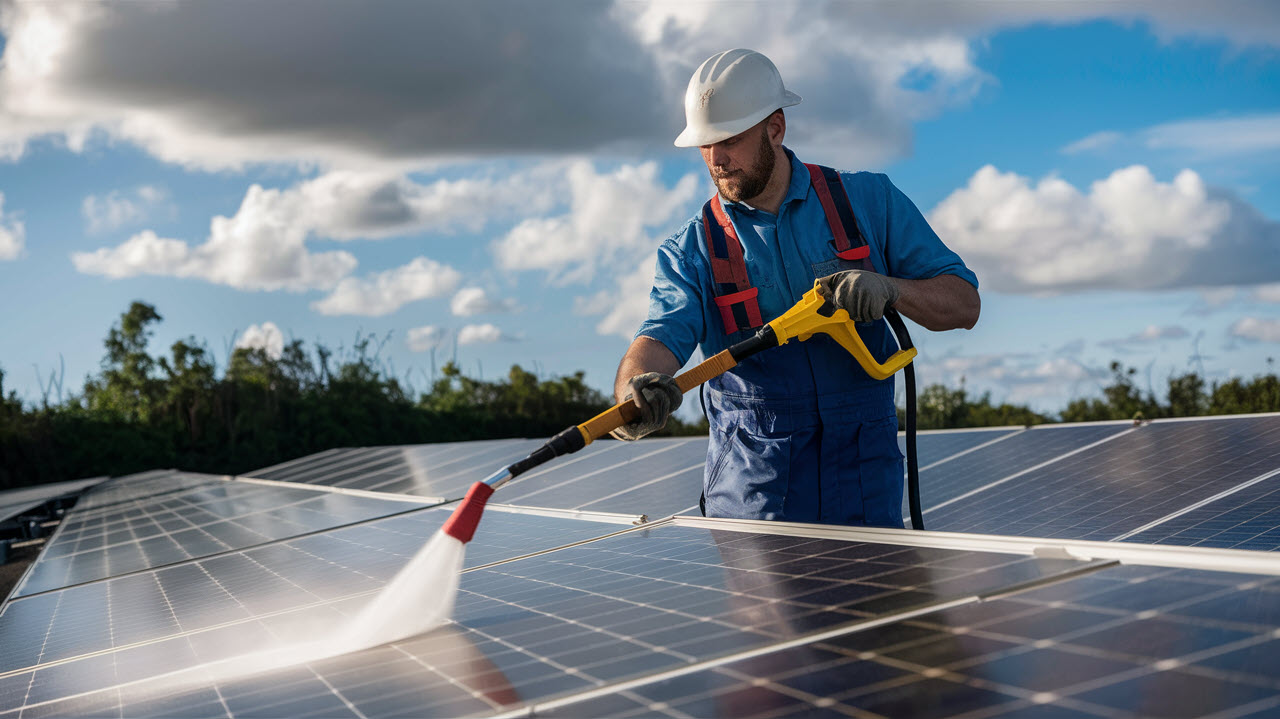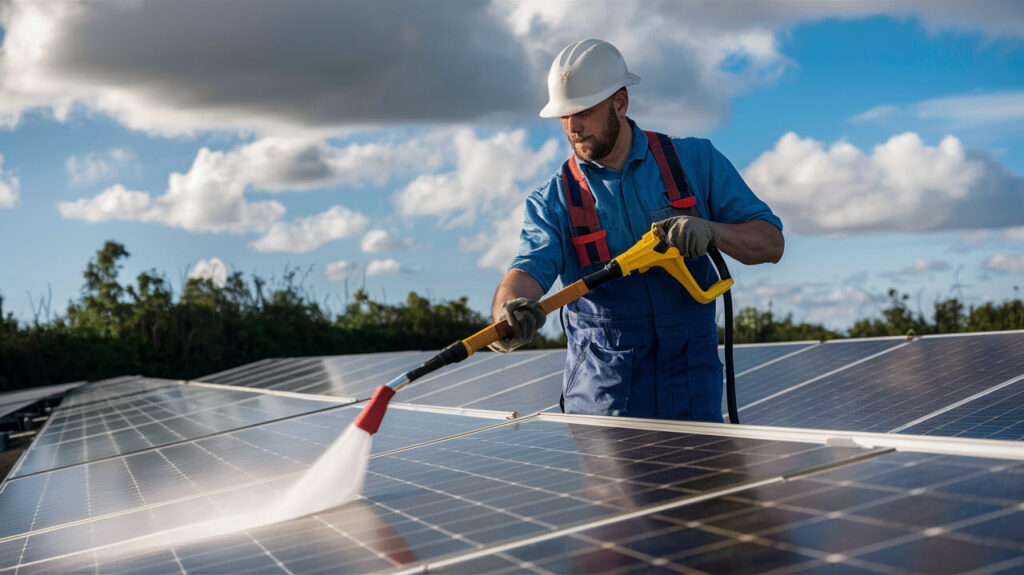
In the quest for sustainable energy solutions, industrial-scale solar panels lead the progress. They bring a critical challenge: the efficient cleaning of vast arrays of solar panels. Keep reading to learn about the solutions for cleaning industrial solar panels and the cutting-edge technologies that are starting to emerge.

Industrial-scale solar panel installations are large-scale photovoltaic (PV) systems that generate electricity on an industrial scale. Their main characteristics are:
Size
Industrial-scale solar panel installations consist of thousands to millions of solar panels and cover vast areas and rooftops. The size of such installations varies from several acres to hundreds of acres or more.
Complexity
Typically, industrial-scale solar panel installations are complex engineering projects that require careful design, planning, and implementation. They have several components, such as solar panels, inverters, mounting structures, monitoring systems, and electrical wiring. Sun exposure, shading terrain, and environmental conditions will weigh in on the design and layout of the installation.
Applications
The applications for industrial solar panel systems are many, including:
They are connected to the utility grid and are located in rural or remote areas with generous sunlight and available land.
Large commercial and industrial buildings often have solar panels or rooftops to produce energy for on-site use. Such installations reduce the energy costs and carbon footprint of businesses.
Industrial solar power plants generate electricity for large-scale industrial or municipal use. Such plants may also include concentrating solar power technology (CSP) which uses mirrors or lenses to focus sunlight onto a receiver to generate electricity.
Industrial solar panel installations may be conceived as community solar projects, where several stakeholders share the benefits of solar energy. Such systems allow individuals, businesses, or communities to use solar energy without turning to rooftop installation.
Cleaning is crucial for industrial-scale solar panels for several reasons:
Dirt, dust, debris, and other particles on the solar panels' surface will stop the sunlight from penetrating. Regular cleaning helps the panels absorb the maximum amount of sunlight and generate the highest level of energy output.
Deposits of dirt, dust, and debris will decrease the transparency of solar panels. The layer will become a barrier that reduces the efficiency of photovoltaic cells in turning sunlight into electricity. Regular cleaning will maintain the efficiency of the solar panels and avoid financial losses.
Partial shading of a single solar panel within an array may have a cascading effect and decrease the efficiency of neighbouring panels. Regular cleaning will ensure uniform sunlight exposure across all panels and eliminate shading effects. Cleaning prevents shading and, therefore, improves the performance of the solar panels.
Adequate maintenance and regular cleaning extend the durability of solar panels. Dirt and debris buildup will create hotspots on the panels, cause thermal stress and possibly damage the cells or module materials. Regular cleaning will prevent degradation and expand the durability of the solar panels.
Industrial-scale solar panels are a big investment and regular cleaning will help the system work as expected for the longest time.
The challenges in cleaning industrial-scale solar panels are mostly related to their size, accessibility, and logistics. Here are the details:
Industrial-scale solar panel arrays typically cover vast areas of land or roofs and include thousands and even millions of individual solar panels. Cleaning such panels takes a lot of time and effort and important resources and manpower are necessary.
Sometimes, solar panels are installed on rooftops, uneven terrain, or elevated structures. Therefore, access will be possible with specialized equipment. Also, the cleaners will need to follow strict safety protocols and find access to all areas of the array.
Coordinating the logistics of cleaning large-scale solar panel arrays is another challenge. The professional will carefully plan and coordinate the personnel, equipment, and resources. They will manage scheduling, transportation, and site preparations for effective cleaning. Logistical challenges increase for remote or off-grid installations with limited infrastructure or support services.
Safety is a paramount problem when cleaning solar panels, especially when working at heights. The professionals follow safety protocols and use equipment to reduce the risk of accidents or injuries during cleaning. Such measures maintain productivity and prevent downtime due to mishaps or accidents.
Large-scale solar panels may be installed in various environments, from coastal areas to urban environments. Weather patterns, pollution levels, and wildlife habitats weigh in the cleaning procedures. Professionals employ sustainable cleaning techniques to reduce the impact on the environment.
The techniques used in cleaning industrial-scale solar panels are various. Professionals will select the cleaning technique according to the level of dirtiness, size of installation, access to the panels, and environmental aspects. The most common cleaning methods used for industrial-scale solar panels are:
Water-based cleaning
Water-based cleaning methods refer to using water with or without mild detergents or cleaning agents. The method will rinse away dirt, dust, debris, and particles from the solar panels' surface. The method removes loose contaminants. Hoses, pressure washers, and automated cleaning can be used to spray water.
Pressure washing
Pressure washing uses high-pressure water jets to dislodge difficult dirt, grime, and buildup from the solar panels. Professionals turn to pressure washing to remove heavy soiling and residues. They adjust the pressure according to the panels' sensitivity and cleaning requirements.
Brushing
With brushing, the technicians will use soft-bristled brushes or scrubbers to manually agitate and remove dust, dirt, and debris from the solar panels. Professionals use brushing for light cleaning. They may use manual or automated brush systems, depending on the size and access to the panels.
Chemical treatments
Chemical treatments consist of applying specialized cleaning agents or solutions to solar panels to dissolve and eliminate difficult contaminants (bird droppings, mineral deposits, or sap). The professionals will use environmentally friendly and non-corrosive chemicals to protect the panels and the environment.
Waterless cleaning
Dry brushing and using microfiber cloths are waterless cleaning methods. They remove light dust and dirt from solar panels without water.
Solar panel coatings
Some industrial solar panels can have self-cleaning or anti-soiling coatings that repel dirt, dust, and water so they don't need frequent cleaning. The coatings improve the efficiency and durability of solar panels as they prevent buildup of contaminants.
In the last few years, new and innovative cleaning methods have been conceived especially for industrial-scale solar panel cleaning. Such technologies improve efficiency, lower labour costs, and enhance safety in solar panel maintenance. The most relevant examples are:
Automated robotic systems are conceived to autonomously cross over solar panel arrays. They use sensors and navigation technology to detect and go around obstacles. Such systems feature brushes, wipers, and sprayers to remove dust, dirt, and debris from solar panels.
Automated robotic systems can run continuously and quickly over vast areas. They reduce the need for manual labour and improve cleaning. Some robotic systems also feature self-charging abilities and automatically recharge when the batteries are low.
Some robotic systems may integrate artificial intelligence (AI) algorithms to improve cleaning routes and adapt to changing environmental conditions.
Aerial cleaning methods use drones or unmanned aerial vehicles (UAVs) that feature spraying or cleaning equipment to access and clean large-scale solar panels from above. Aerial cleaning is useful for panels on difficult terrain or limited access. They can easily and efficiently cover vast areas.
Drones with spraying or cleaning attachments fly over solar panel arrays and apply cleaning solutions or water to remove dirt and debris from panels. It's possible to program drones to follow a predefined flight path. Operators on the ground can also remotely control the drones.
Drones can also be used for inspection so that operators examine the condition of solar panels, detect defects or damage, and plan maintenance activities.
Professionals execute industrial-scale solar panel cleaning with careful coordination and adherence to best practices. Here are some key aspects of industrial-scale solar panel cleaning:
Scheduling
Professionals conceive a complex cleaning schedule by considering aspects such as weather patterns, seasonal variations, and energy production demands. To avoid disruptions and ensure cleaning efficiency, the cleaning will take place when the energy production is low or the weather is favourable.
Allocate resources
The cleaning company will allocate personnel, equipment, and cleaning supplies according to the size and purpose of the cleaning. The professional team will also consider the availability of water, power sources, and any infrastructure necessary for cleaning.
Inspect the site
Professionals will inspect the site to detect any possible hazards, accessibility problems, and environmental aspects that may impede the cleaning procedures. They will examine the condition of solar panels, mounting structures, and surrounding terrain to choose the best cleaning methods and equipment.
Select the equipment
The technicians will choose the cleaning equipment and tools according to the size, layout, and type of solar panels. They consider terrain, access, and environment when selecting the methods.
Follow safety protocols
The professionals will follow safety protocols to reduce the risk of accidents and injuries during cleaning. They use personal protective equipment (PPE), and fall protection, and are familiar with emergency procedures.
Coordination
The professional cleaners coordinate procedures with stakeholders (site owners, contractors, operators, and utility companies) for smooth cleaning.
Consider the impact on the environment
The professionals will consider the environmental impact of cleaning and integrate measures to reduce any adverse effects. They will use environmentally friendly cleaning agents and methods, and avoid cleaning during sensitive periods (nesting season for birds and flowering seasons). They will properly dispose of waste materials and comply with local regulations and environmental standards.